Topology Optimization-Based Damage Identification Using Visualized Ultrasonic Wave Propagation
Abstract
1. Introduction
2. Damage Identification Procedure
2.1. Concept of Damage Identification
2.2. Setup of Optimization Problem
3. Numerical Examples
3.1. Numerical Models
3.2. Damage Identification for Numerical Results
3.3. Effect of the Penalization Exponent
4. Application
4.1. Experiment
4.2. Damage Identification for Experimental Results
5. Conclusions
- The actual damage state was successfully estimated in the numerical examples. The damage was identified with high accuracy using ultrasonic propagation data from two directions to increase the sensitivity of the objective function in the whole design domain.
- The effect of the penalization exponent p for determining Young’s modulus and the efficiency of the damage identification was investigated. The standard value (p = 3) in the structural design problems resulted in moderate damage severity in the actual damaged area. In contrast, a penalization exponent less than unity resulted in higher damage severity in that area, and the difference between the damage parameter value between ‘damaged’ and ‘intact’ regions was greater than that in the case of p = 3. The penalization exponent within the range 0.5 ≤ p ≤ 1 enabled setting a threshold to distinguish between damaged elements from intact ones.
- The proposed method was applied to experimentally measured wave propagation in an aluminum plate with an artificial crack. The actual damaged area was estimated, and the estimated damage state and the sensitivity of the objective function had the same tendency as a similar numerical example. This demonstrated the feasibility of the proposed method.
Author Contributions
Funding
Conflicts of Interest
References
- Achenbach, J.D. Quantitative nondestructive evaluation. Int. J. Solids Struct. 2000, 37, 13–27. [Google Scholar] [CrossRef]
- Thompson, R.B. Quantitative ultrasonic nondestructive evaluation methods. J. Appl. Mech. 1983, 50, 1191–1201. [Google Scholar] [CrossRef][Green Version]
- Rose, J.L. Ultrasonic Waves in Solid Media; Cambridge University Press: Cambridge, UK, 1999; pp. 101–142. [Google Scholar]
- Su, Z.; Ye, L.; Lu, Y. Guided Lamb waves for identification of damage in composite structures: A review. J. Sound Vib. 2006, 295, 753–780. [Google Scholar] [CrossRef]
- Moilanen, P. Ultrasonic guided waves in bone. IEEE T. Ultrason. Ferr. 2008, 55, 1277–1286. [Google Scholar] [CrossRef] [PubMed]
- Drinkwater, B.W.; Wilcox, P.D. Ultrasonic arrays for non-destructive evaluation: A review. NDT & E Int. 2006, 39, 525–541. [Google Scholar]
- Takeda, S.; Okabe, Y.; Takeda, N. Delamination detection in CFRP laminates with embedded small-diameter fiber Bragg grating sensors. Compos. Part A. 2002, 33, 971–980. [Google Scholar] [CrossRef]
- Okabe, Y.; Fujibayashi, K.; Shimazaki, M.; Soejima, H.; Ogisu, T. Delamination detection in composite laminates using dispersion change based on mode conversion of Lamb waves. Smart Mater. Struct. 2010, 19, 115013. [Google Scholar] [CrossRef]
- Yu, F.; Okabe, Y.; Wu, Q.; Shigeta, N. A novel method of identifying damage types in carbon fiber-reinforced plastic cross-ply laminates based on acoustic emission detection using a fiber-optic sensor. Compos. Sci. Technol. 2016, 135, 116–122. [Google Scholar] [CrossRef]
- Veroy, K.L.; Wooh, S.-C.; Shi, Y. Analysis of dispersive waves using the wavelet transform. In Review of Progress in Quantitative Nondestructive Evaluation; Thompson, D.O., Chimenti, D.E., Eds.; Springer: Boston, MA, USA, 1999; Volume 18 A, pp. 687–694. [Google Scholar]
- Choi, J.; Hong, J.-W. Characterization of wavelet coefficients for ultrasonic signals. J. Appl. Phys. 2010, 107, 114909. [Google Scholar] [CrossRef]
- Barry, T.J.; Kesharaju, M.; Nagarajah, C.R.; Palanisamy, S. Defect characterisation in laminar composite structures using ultrasonic techniques and artificial neural networks. J. Compos. Mater. 2015, 50, 861–871. [Google Scholar] [CrossRef]
- Oishi, A.; Yamada, K.; Yoshimura, S.; Yagawa, G. Quantitative nondestructive evaluation with ultrasonic method using neural networks and computational mechanics. Comput. Mech. 1995, 15, 521–533. [Google Scholar] [CrossRef]
- Takatsubo, J.; Wang, B.; Tsuda, H.; Toyama, N. Generation laser scanning method for the visualization of ultrasounds propagating on a 3-D object with an arbitrary shape. J. Solid Mech. Mater. Eng. 2007, 1, 1405–1411. [Google Scholar] [CrossRef]
- Yashiro, S.; Takatsubo, J.; Miyauchi, H.; Toyama, N. A novel technique for visualizing ultrasonic waves in general solid media by pulsed laser scan. NDT E Int. 2008, 41, 137–144. [Google Scholar]
- Yashiro, S.; Takatsubo, J.; Toyama, N. An NDT technique for composite structures using visualized Lamb-wave propagation. Compos. Sci. Technol. 2007, 67, 3202–3208. [Google Scholar] [CrossRef]
- Sohn, H.; Dutta, D.; Yang, J.Y.; Park, H.J.; DeSimio, M.; Olson, S.; Swenson, E. Delamination detection in composites through guided wave field image processing. Compos. Sci. Technol. 2011, 71, 1250–1256. [Google Scholar] [CrossRef]
- Chia, C.C.; Lee, J.-R.; Park, C.-Y.; Jeong, H.-M. Laser ultrasonic anomalous wave propagation imaging method with adjacent wave subtraction: Application to actual damages in composite wing. Opt. Laser Technol. 2012, 44, 428–440. [Google Scholar] [CrossRef]
- Lee, J.-R.; Chia, C.C.; Park, C.-Y.; Jeong, H. Laser ultrasonic anomalous wave propagation imaging method with adjacent wave subtraction: Algorithm. Opt. Laser Technol. 2012, 44, 1507–1515. [Google Scholar] [CrossRef]
- Kudela, P.; Radzienski, M.; Ostachowicz, W. Impact induced damage assessment by means of Lamb wave image processing. Mech. Syst. Signal Pr. 2018, 102, 23–36. [Google Scholar] [CrossRef]
- Yashiro, S.; Toyama, N.; Takatsubo, J.; Shiraishi, T. Laser-generation based imaging of ultrasonic wave propagation on welded steel plates and its application to defect detection. Mater. Trans. 2010, 51, 2069–2075. [Google Scholar] [CrossRef]
- Toyama, N.; Yamamoto, T.; Urabe, K.; Tsuda, H. Ultrasonic inspection of adhesively bonded CFRP/aluminum joints using pulsed laser scanning. Adv. Compos. Mater. 2019, 28, 27–35. [Google Scholar] [CrossRef]
- Lee, J.-R.; Chia, C.C.; Shin, H.J.; Park, C.-Y.; Yoon, D.J. Laser ultrasonic propagation imaging method in the frequency domain based on wavelet transformation. Opt. Laser. Eng. 2011, 49, 167–175. [Google Scholar] [CrossRef]
- Michaels, T.E.; Michaels, J.E.; Ruzzene, M. Frequency-wavenumber domain analysis of guided wavefields. Ultrason. 2011, 51, 452–466. [Google Scholar] [CrossRef] [PubMed]
- Rogge, M.D.; Leckey, C.A. Characterization of impact damage in composite laminates using guided wavefield imaging and local wavenumber domain analysis. Ultrason 2013, 53, 1217–1226. [Google Scholar] [CrossRef] [PubMed]
- Park, B.; An, Y.-K.; Sohn, H. Visualization of hidden delamination and debonding in composites through noncontact laser ultrasonic scanning. Compos. Sci. Technol. 2014, 100, 10–18. [Google Scholar] [CrossRef]
- An, Y.-K. Impact-induced delamination detection of composites based on laser ultrasonic zero-lag cross-correlation imaging. Adv. Mater. Sci. Eng. 2016, 2016, 6474852. [Google Scholar] [CrossRef]
- Toyama, N.; Ye, J.; Kokuyama, W.; Yashiro, S. Non-contact ultrasonic inspection of impact damage in composite laminates by visualization of Lamb wave propagation. Appl. Sci. 2019, 9, 46. [Google Scholar] [CrossRef]
- Ye, J.; Ito, S.; Toyama, N. Computerized ultrasonic imaging inspection: From shallow to deep learning. Sensors 2018, 18, 3820. [Google Scholar] [CrossRef]
- Bendsøe, M.P.; Kikuchi, N. Generating optimal topologies in structural design using a homogenization method. Comput. Methods Appl. Mech. Eng. 1988, 71, 197–224. [Google Scholar] [CrossRef]
- Bendsøe, M.P. Optimal shape design as a material distribution problem. Struct. Optim. 1989, 1, 193–202. [Google Scholar] [CrossRef]
- Sigmund, O. A 99 line topology optimization code written in Matlab. Struct. Multidiscip. Optim. 2001, 21, 120–127. [Google Scholar] [CrossRef]
- Zargham, S.; Ward, T.A.; Ramli, R.; Badruddin, I.A. Topology optimization: a review for structural designs under vibration problems. Struct. Multidiscip. Optim. 2016, 53, 1157–1177. [Google Scholar] [CrossRef]
- Lee, J.S.; Kim, J.E.; Kim, Y.Y. Damage detection by the topology design formulation using modal parameters. Int. J. Numer. Meth. Eng. 2007, 69, 1480–1498. [Google Scholar] [CrossRef]
- Nishizu, T.; Takezawa, A.; Kitamura, M. Eigenfrequecy-based damage identification method for non-destructive testing based on topology optimization. Eng. Optim. 2017, 49, 417–433. [Google Scholar] [CrossRef]
- Reumers, P.; Van hoorickx, C.; Schevenels, M.; Lombaert, G. Density filtering regularization of finite element model updating problems. Mech. Syst. Signal Pr. 2019, 128, 282–294. [Google Scholar] [CrossRef]
- Eslami, S.M.; Abdollahi, F.; Shahmiri, J.; Tavakkoli, S.M. Structural damage detection by using topology optimization for plane stress problems. Int. J. Optim. Civil Eng. 2019, 9, 159–176. [Google Scholar]
- Niemann, H.; Morlier, J.; Shahdin, A.; Gourinat, Y. Damage localization using experimental modal parameters and topology optimization. Mech. Syst. Signal Pr. 2010, 24, 636–652. [Google Scholar] [CrossRef]
- Shahdin, A.; Morlier, J.; Niemann, H.; Gourinat, Y. Correlating low energy impact damage with changes in modal parameters: diagnosis tools and FE validation. Struct. Health Monit. 2011, 10, 199–217. [Google Scholar] [CrossRef]
- Morlier, J.; Niemann, H.; Shahdin, A. Topology optimization for robust damage localization using aggregated FRFs statistical criteria. Appl. Mech. Mater. 2014, 629, 513–518. [Google Scholar] [CrossRef]
- Smith, W.D. A nonreflecting plane boundary for wave propagation problems. J. Comput. Phys. 1974, 15, 492–503. [Google Scholar] [CrossRef]
- Bendsøe, M.P.; Sigmund, O. Material interpolation schemes in topology optimization. Arch. Appl. Mech. 1999, 69, 635–654. [Google Scholar] [CrossRef]
- Hashin, Z.; Shtrikman, S. A variational approach to the theory of the elastic behaviour of multiphase materials. J. Mech. Phys. Solids. 1963, 11, 127–140. [Google Scholar] [CrossRef]
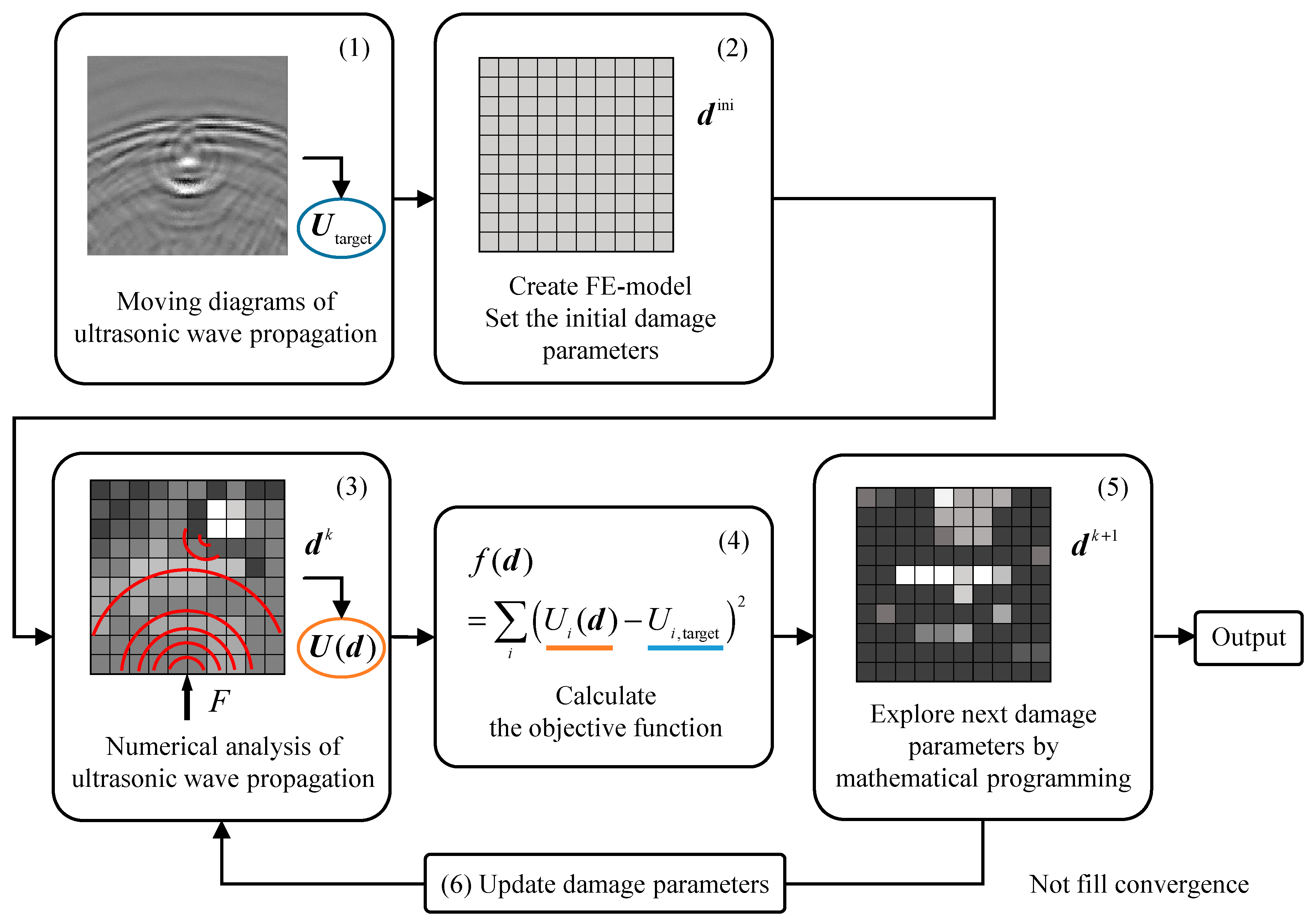
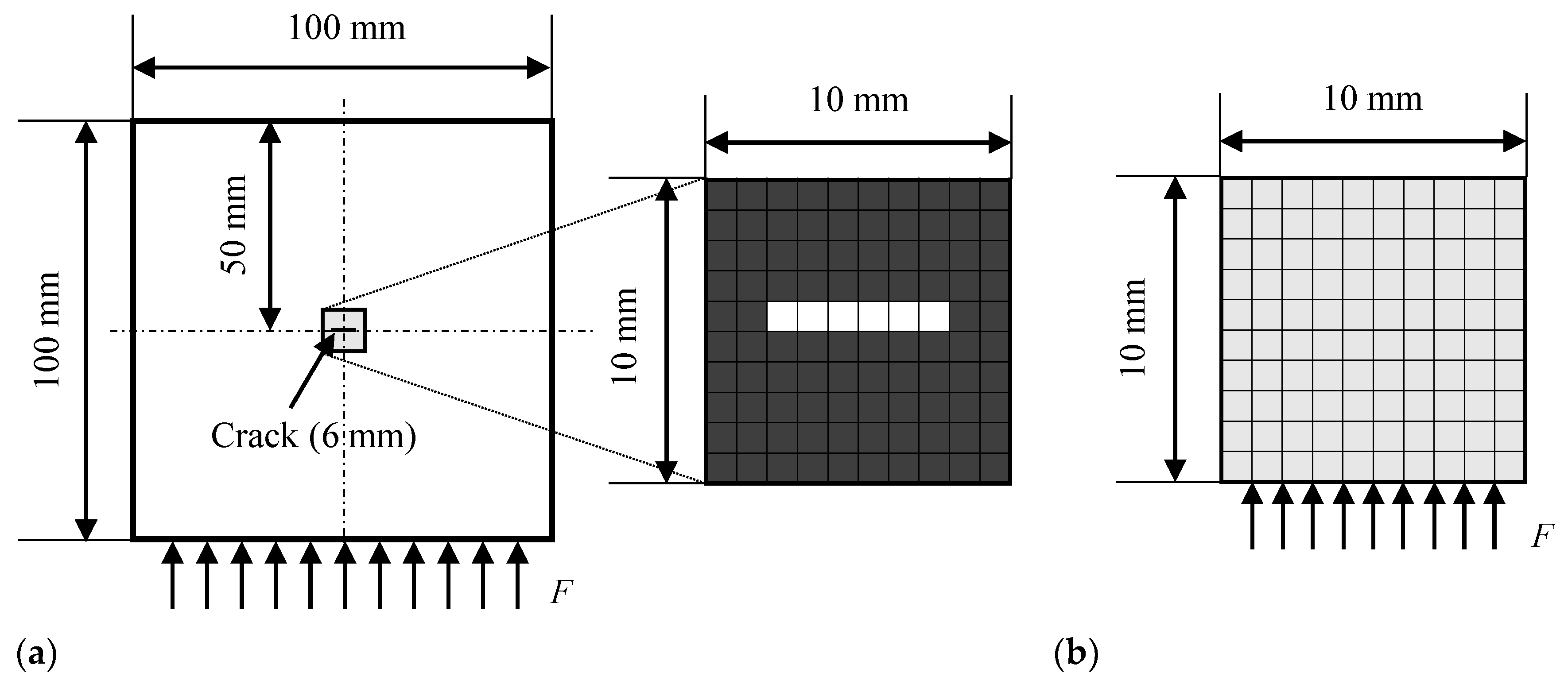
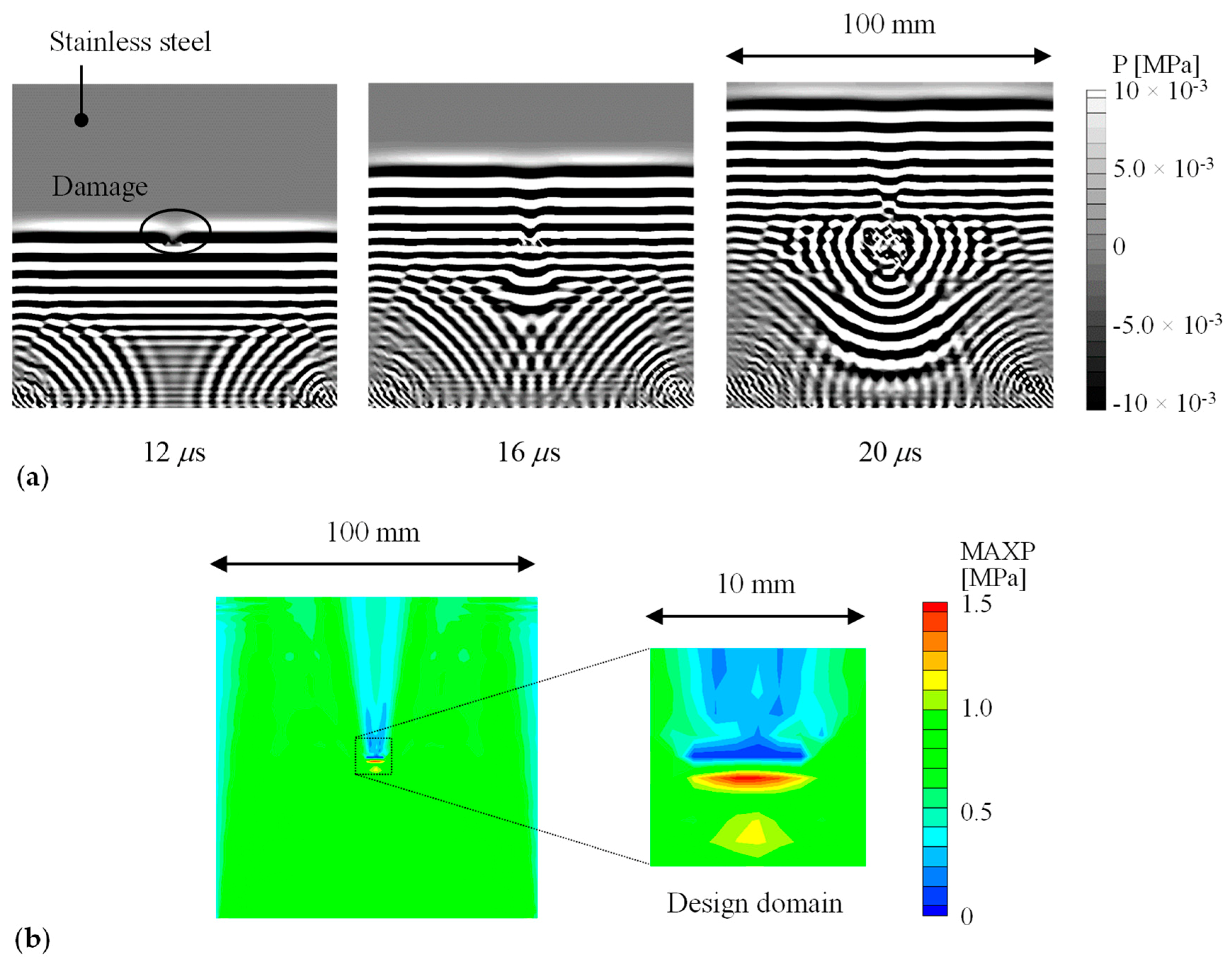
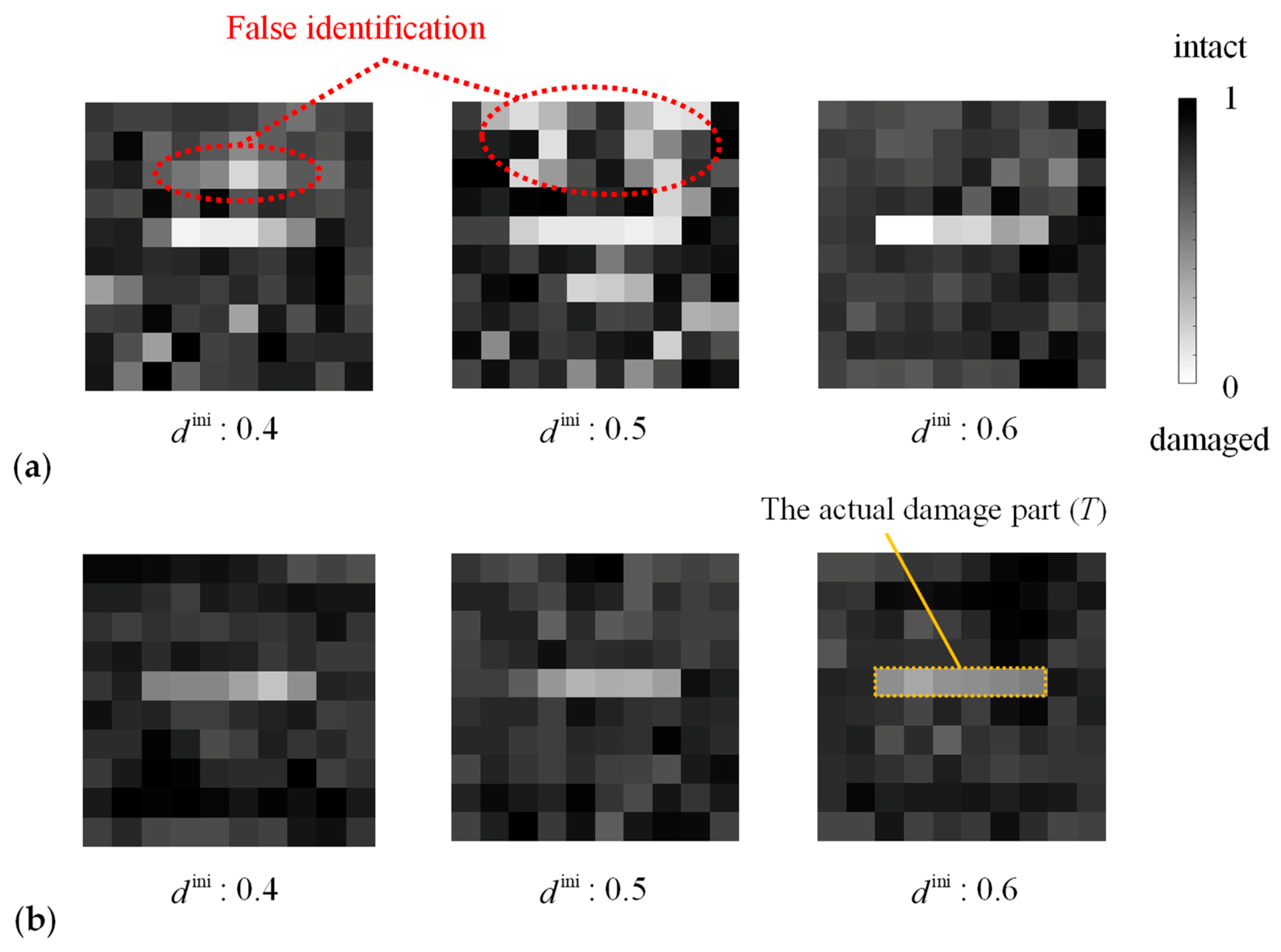
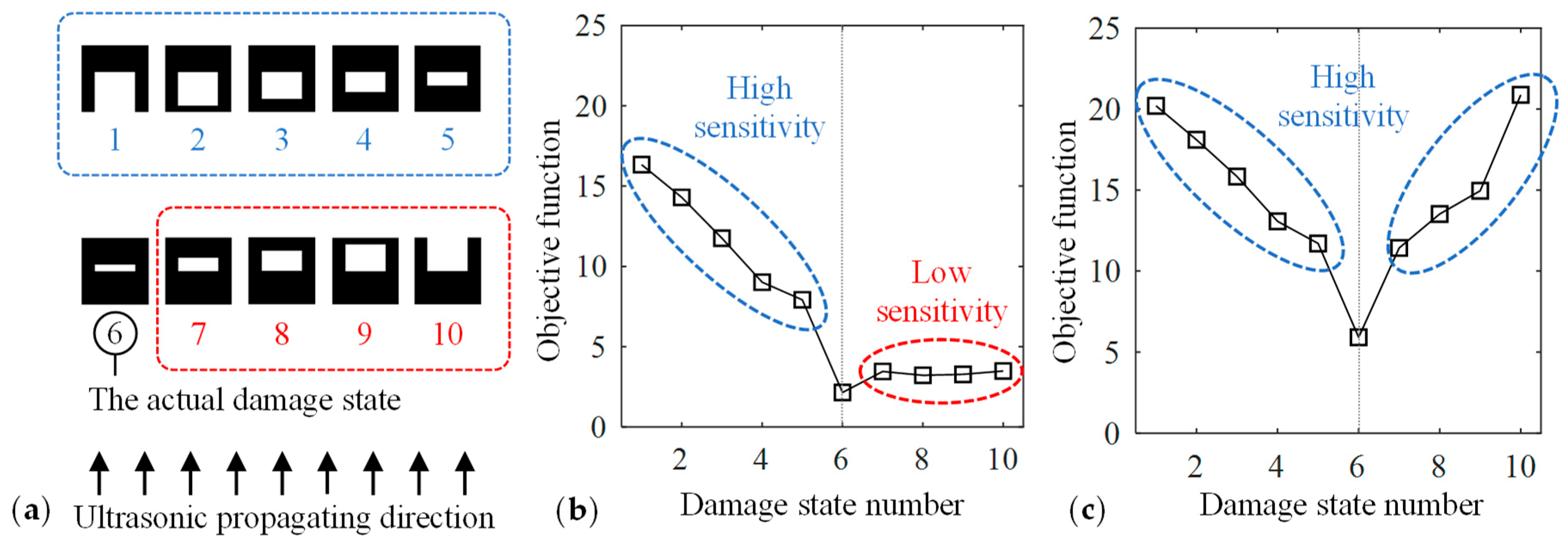

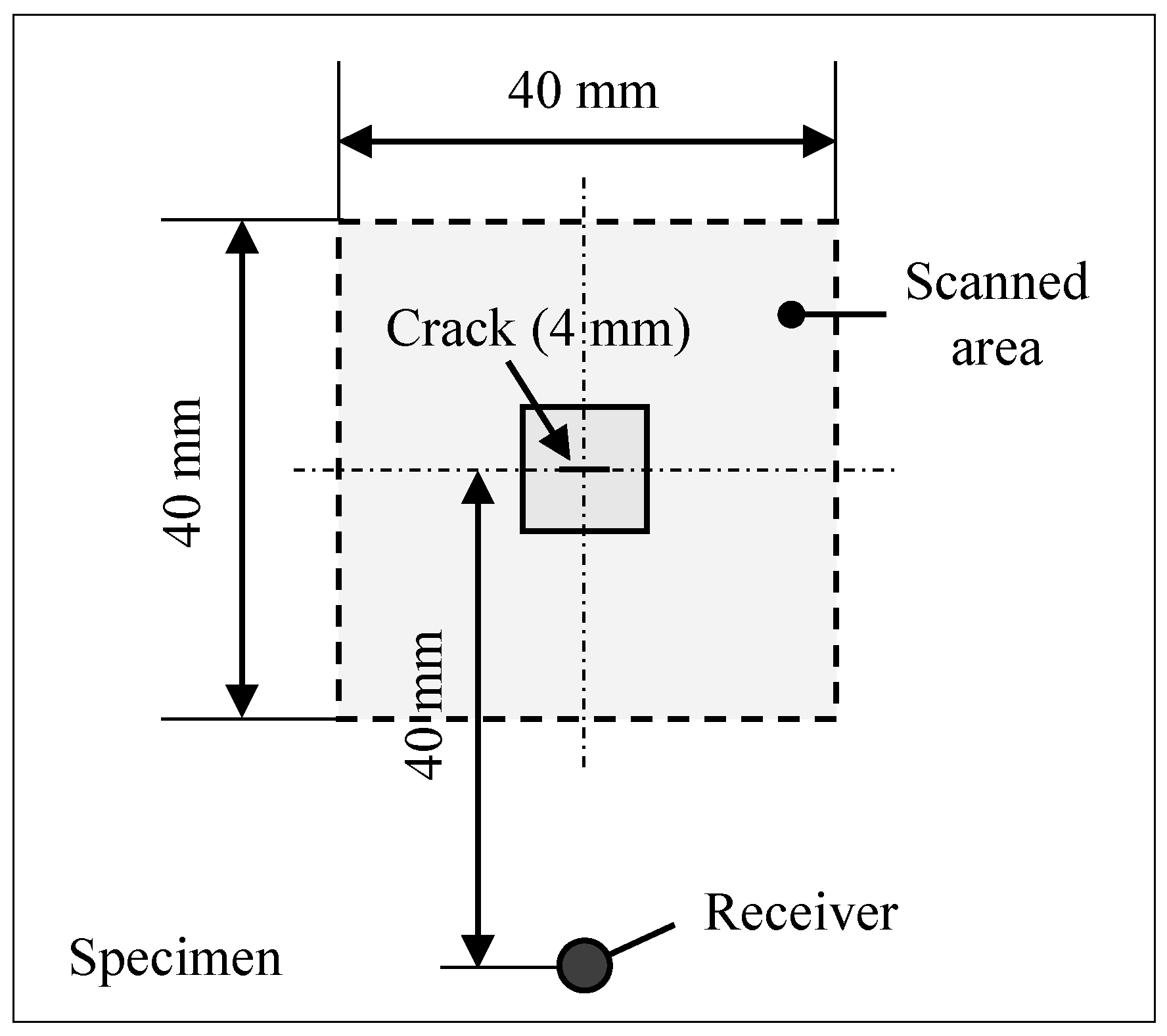
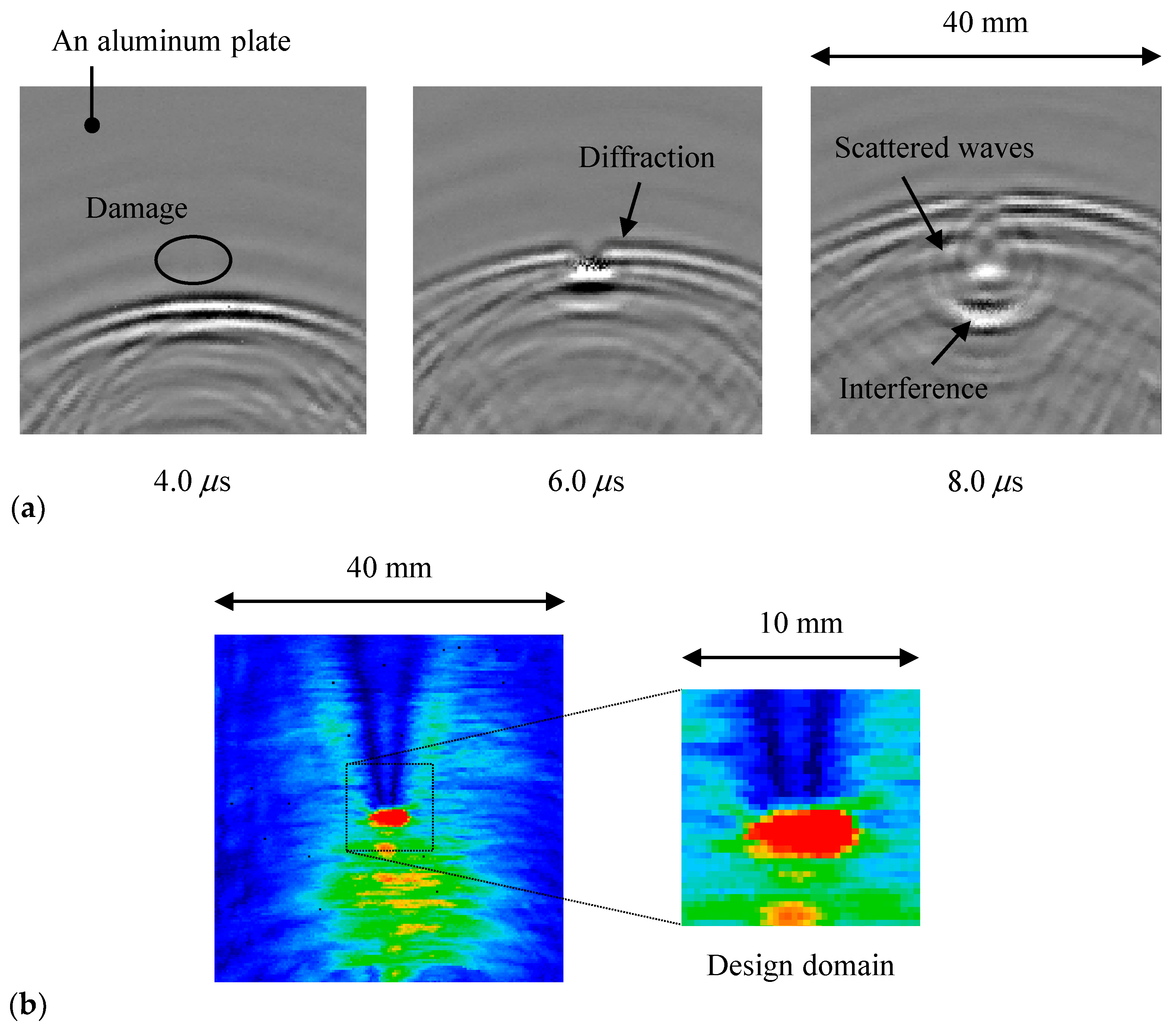
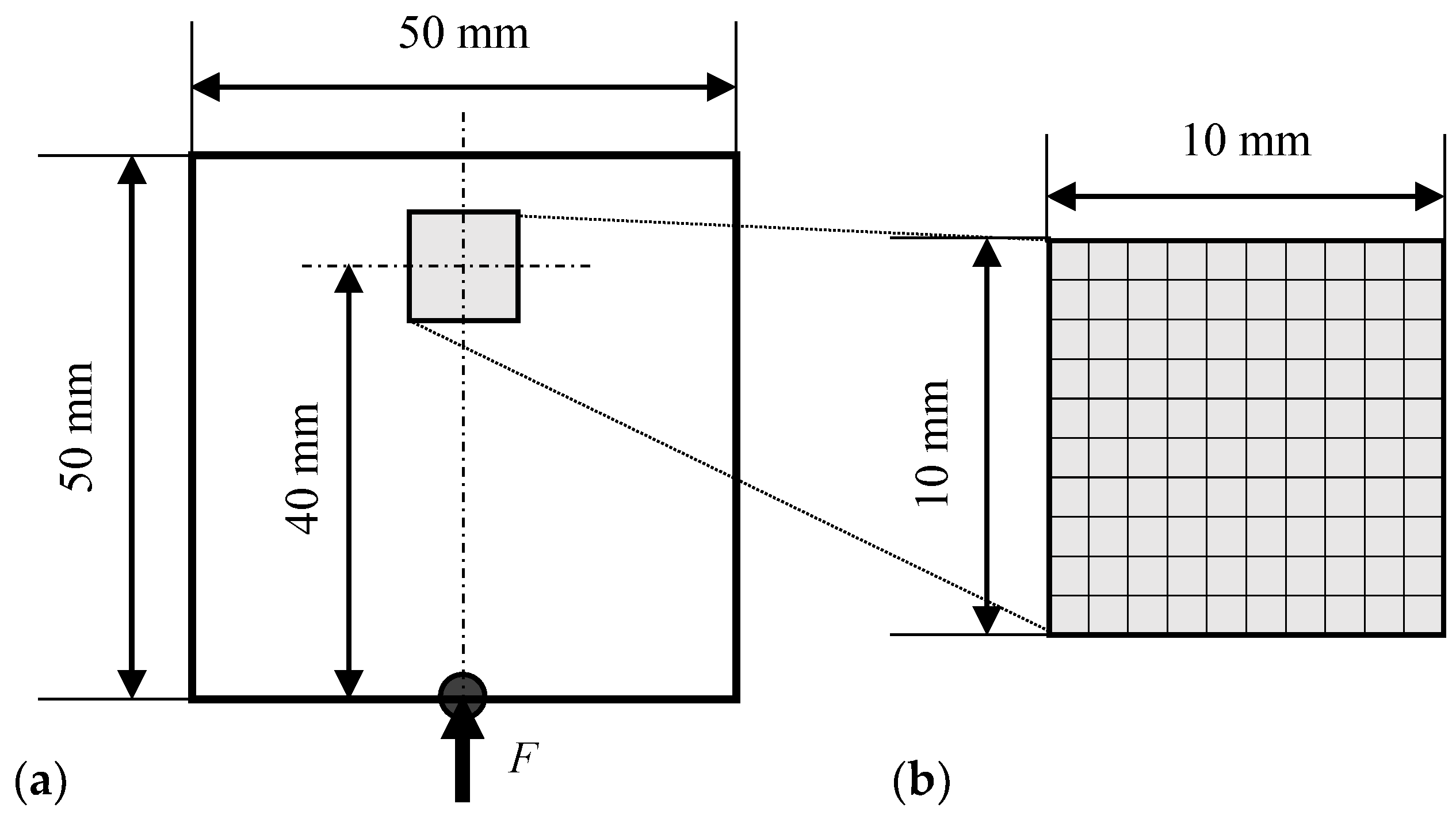
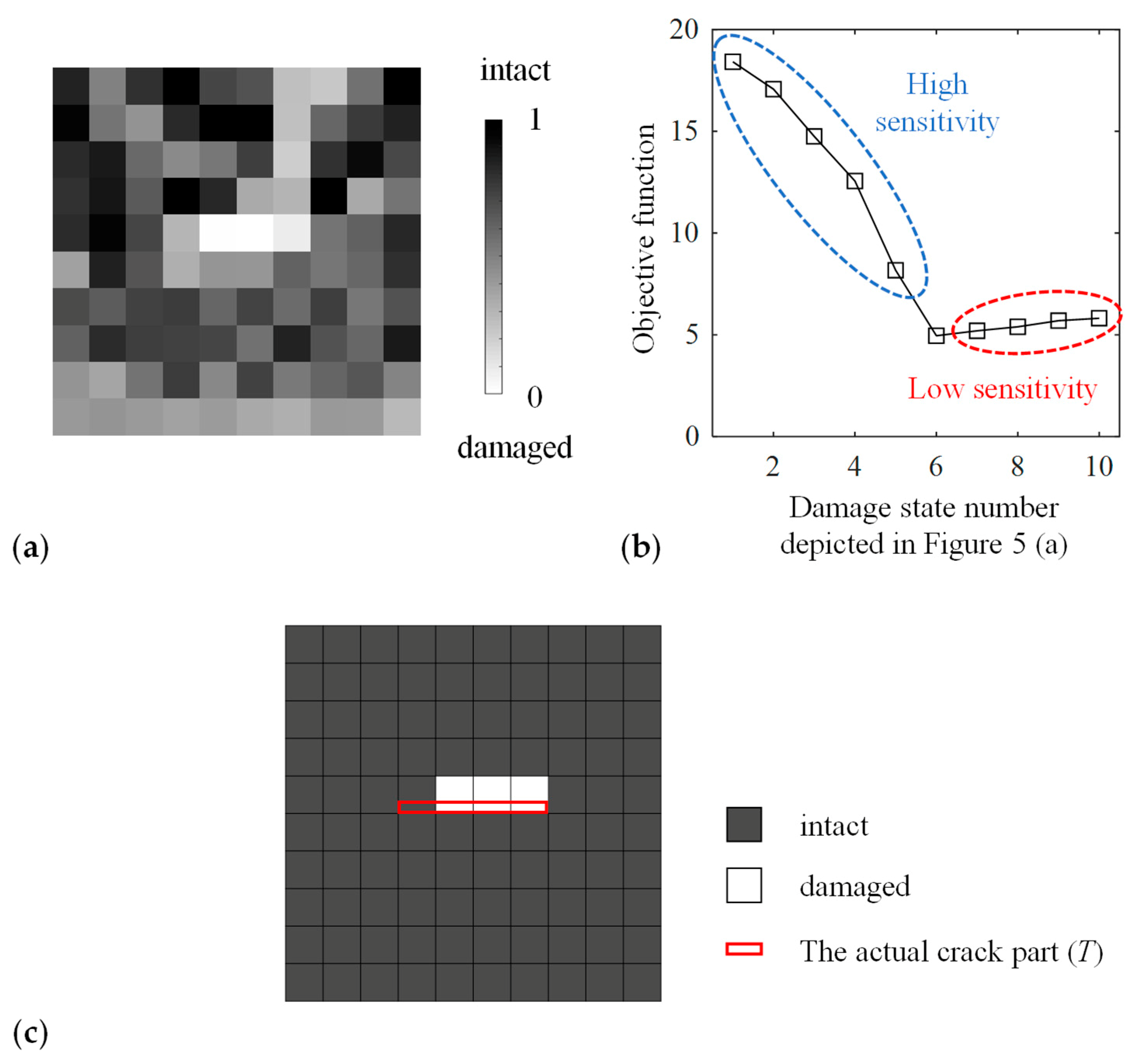
© 2019 by the authors. Licensee MDPI, Basel, Switzerland. This article is an open access article distributed under the terms and conditions of the Creative Commons Attribution (CC BY) license (http://creativecommons.org/licenses/by/4.0/).
Share and Cite
Ryuzono, K.; Yashiro, S.; Nagai, H.; Toyama, N. Topology Optimization-Based Damage Identification Using Visualized Ultrasonic Wave Propagation. Materials 2020, 13, 33. https://doi.org/10.3390/ma13010033
Ryuzono K, Yashiro S, Nagai H, Toyama N. Topology Optimization-Based Damage Identification Using Visualized Ultrasonic Wave Propagation. Materials. 2020; 13(1):33. https://doi.org/10.3390/ma13010033
Chicago/Turabian StyleRyuzono, Kazuki, Shigeki Yashiro, Hiroto Nagai, and Nobuyuki Toyama. 2020. "Topology Optimization-Based Damage Identification Using Visualized Ultrasonic Wave Propagation" Materials 13, no. 1: 33. https://doi.org/10.3390/ma13010033
APA StyleRyuzono, K., Yashiro, S., Nagai, H., & Toyama, N. (2020). Topology Optimization-Based Damage Identification Using Visualized Ultrasonic Wave Propagation. Materials, 13(1), 33. https://doi.org/10.3390/ma13010033




